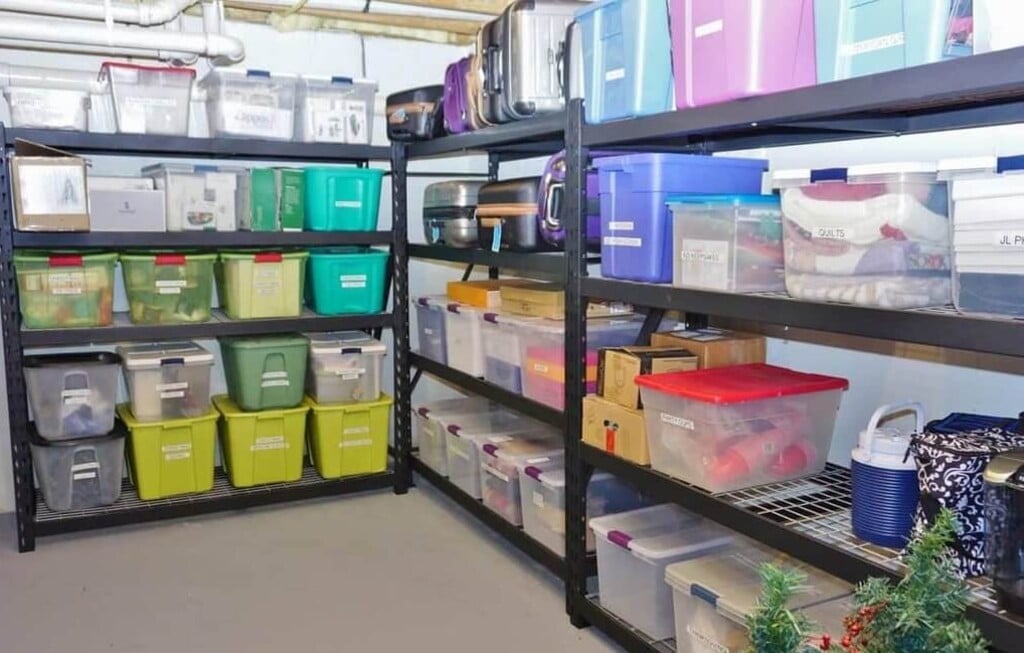Basements can be a catch-22 of storage. You have all this unused, wide-open space, but you have to be careful what you keep there because of the climate. It’s like having another room in your home—but you can’t use it for just anything.
The typical basement is cool and dark. You can add artificial lighting, but the area stays damp and musty without enough windows for natural light. It’s empty space that ends up wasted unless you clean up the area and dry it out.
However, if you know the tricks to basement organization, you can store almost anything in this versatile space. When you use these 5 tips as you plan how to utilize your basement area, you can make the most out of this extra square footage.
1. Think Vertically
The best way to make use of your basement (and any room) is to maximize your wall space.
Aesthetics aside, basements are naturally prone to flooding. When the water in the ground around your home saturates, it heads straight for your basement. The more you can add high shelves and storage on your walls, the safer your belongings will be.
For instance, install a bike parking rack across the ceiling or high up on the wall if you have bicycles and gear you want to keep dry. Keep a short ladder nearby so you can easily access anything out of reach.
And as a pro tip, if you have a basement, you should also have a sump pump. It’s one of those devices that you hope you don’t need to use, but when you do, it can be a lifesaver.
2. Don’t Keep Everything

Before reorganizing your basement, do a quick “spring cleaning” purge. You might find that all the things you thought you had to have in the past don’t matter quite as much anymore.
When was the last time you used each item you planned to store in the room? Is it valuable enough to keep, even if you don’t use it? Or could you donate or sell it to someone who would appreciate it more? If you ever need it in the future, would it be cost-effective to borrow one later instead of keeping it now?
Less clutter means easier organization. By getting rid of the miscellaneous “junk” items you don’t really have a purpose for, you can label your bins and shelves and keep everything under control.
3. Better Safe Than Sorry with Your Valuables
Here’s a rule of thumb to keep in mind with basement storage etiquette. Just because you can fit something in there doesn’t mean you should.
This is particularly true for items that can be ruined if they get damp. No matter how climate-controlled you keep your basement, it gets cool and humid. If it’s not entirely waterproof, it’s the perfect home for mold and mildew growth.
For that reason, you should never store anything valuable that can be damaged with moisture. This includes bed linens and mattresses or pillows, paper memorabilia or collectible items, and anything made out of wood or cardboard.
4. Use Zoning Techniques
Now that you have a better idea of what you want to store in your basement, it’s time to decide where each item goes. Vertical space is an amazing marvel of organization—as long as you use it well.
Split your basement into zones to make the most of your shelves and brackets.
Here’s an example of how that would work, although your zones can be whatever works for you:
- Top of the rear wall: holiday decor
- Bottom of the rear wall: seasonal clothing in vacuum-sealed bags
- Left wall: hardware and tools
- Top of the right wall: bike rack and gear
- Bottom of the right wall: canoe and gear
- Front wall: frequently accessed items
Knowing the zones you’ve created helps you grab what you need fast and put it back where it belongs.
5. Don’t Skimp on the Storage Bins

Cardboard boxes are cheap and easy to use, but they also degrade and attract pests. If there’s one thing you want to invest in for basement organization, it’s high-quality, moisture-proof storage bins.
Vacuum-sealed bags do double duty as water-resistant and room-saving storage. Plastic totes should be advertised as water-resistant and tightly sealed. Avoid stackable storage drawers unless what you’re putting in them can’t be damaged by water.
Conclusion
With these 5 tips in mind, you can start the fun of getting your basement in tip-top shape! Also, do not forget about shelf storage. You’ll love the results, and you might just want to organize the rest of your house when you’re done.
Discover More

